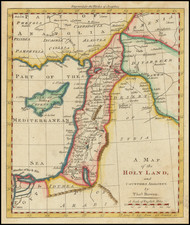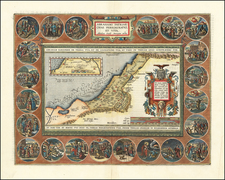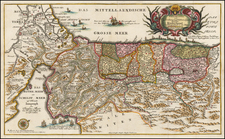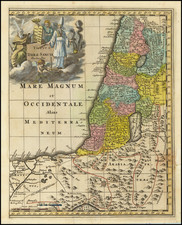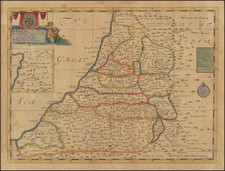This image is an original vintage map poster was issued in 1976 by the Jewish National Fund – Keren Kayemet LeIsrael (KKL-JNF).
The poster map is a colorful representation of the state of Israel's territorial changes following the 1967 Six-Day War. It highlights the 90 existing new settlements established after the Six-Day War, as well as the 55 new settlements that were planned to be established.
The settlements are shown within the "old green border line," which includes regions in the Galilee and the Negev, as well as areas beyond these borders such as the West Bank, the Gaza Strip (prior to the Disengagement), and the Sinai Peninsula. The map reflects the new expanded borders of Israel after the war and includes the settlements within the newly acquired territories.
This map also served a functional purpose as part of a fundraising effort, with a call to raise donations for the KKL-JNF's activities related to these new settlements. The poster not only depicts geographical details but also serves as a historical document, illustrating Israel's territorial expansion and settlement patterns during a pivotal time in its history. The settlements are marked against the backdrop of the expanded borders, underscoring the geopolitical landscape of the era.
Jewish National Fund
The Jewish National Fund (JNF), or Keren Kayemet LeIsrael, is a historic organization that was first conceptualized by Hermann Schapira at the First Zionist Congress in 1897 and formally established at the Fifth Zionist Congress in Basel in 1901. The JNF's mission was fundamentally linked to the establishment of a Jewish homeland through the purchasing and development of land in Palestine.
The initial leadership of the JNF included the Jewish industrialist Johann Kremenezky, who was instrumental in guiding the organization's early years. The JNF's first land purchases, including plots in Judea and the Lower Galilee, laid the groundwork for the future state of Israel. One of the JNF's notable early achievements was the key role it played in the founding of Tel Aviv in 1909, symbolizing the practical realization of Zionist aspirations.
The JNF's "Olive Tree Fund" became a channel for Diaspora Jews to contribute to afforestation efforts in Palestine, which marked the beginnings of the JNF's storied tree-planting campaigns. The iconic Blue Boxes, or pushkes, became a symbol of this partnership, with an estimated one million boxes in Jewish homes globally between the two world wars. The JNF also issued stamps as a fundraising tool, which briefly served as postage stamps during the tumultuous period of the establishment of the State of Israel in May 1948.
During the Ottoman era, the JNF's first land parcel, an olive grove east of Hadera, was donated by the Russian Zionist leader Isaac Leib Goldberg in 1903. The early 20th century saw the JNF acquire land near the Sea of Galilee and at Ben Shemen. By the end of 1935, the JNF held 89,500 acres (362 km²), providing a base for 108 Jewish communities.
Under the British Mandate, the JNF expanded its holdings significantly. By 1948, it owned 54% of the land held by Jews in the region. The eve of statehood saw the JNF in possession of 936,000 dunams of land. Yossef Weitz, the head of its settlement department, was a key figure in these efforts.
With the establishment of Israel in 1948, the government began selling absentee lands to the JNF. On January 27, 1949, and again in October 1950, large tracts of land were sold to the JNF, transactions whose legitimacy has been debated but generally upheld by Israeli legislation.
In 1953, the JNF was reorganized as an Israeli company, reflecting the state's sovereignty. The Israel Land Administration (ILA) was formed in 1960 to manage the land, including that of the JNF, which was instrumental in developing projects such as "Operation Promised Land" to accommodate the influx of Jewish immigrants.
Post-1967, the JNF-KKL began work in the newly occupied territories, focusing on settlement and land development. Its reclamation projects included extensive afforestation, planting millions of trees, and advancing soil and water conservation. The JNF's
efforts in water conservation were significant, with the construction of dams and reservoirs to combat water scarcity. The JNF's collaborative work through the International Arid Land Consortium aimed to develop sustainable ecological practices.
Despite its work in land development and environmental conservation, the JNF has faced controversies, particularly around its leasing policies, which historically allowed only Jews to lease JNF land. This policy led to legal challenges and a significant ruling in 2005 by Israel's Attorney General Menachem Mazuz, who decided that the ILA could not discriminate against Arab citizens of Israel in the allocation of lands it managed. This ruling necessitated a compromise where the ILA would compensate the JNF with equivalent land whenever a non-Jew won an ILA tender for a plot of JNF-owned land.
The JNF's role in the establishment and expansion of settlements, especially after the Six-Day War, has also been a point of contention, with critics arguing that many of the JNF lands were obtained through the displacement of Palestinian populations.
Internationally, the JNF has faced scrutiny and challenges to its charitable status, with calls for transparency in its funding and operations, particularly from its fundraising arms in the United States, the United Kingdom, and Canada. In the UK, the JNF has seen its patronage change and has faced motions in Parliament questioning its charitable status.
Despite these challenges, the JNF has continued its work in afforestation, land development, and water conservation. It has played a part in planning public parks and civic amenities, even assisting the Palestinian Authority in the development of Rawabi. The organization's commitment to ecological practices and its role in the development of infrastructure for new communities, particularly in the Galilee and Negev, underscore its ongoing influence on the landscape and demography of Israel.
The JNF remains a complex figure within the Israeli and Jewish narrative, embodying the intersection of environmental stewardship, national development, and the fraught politics of land in Israel and the Palestinian territories.









